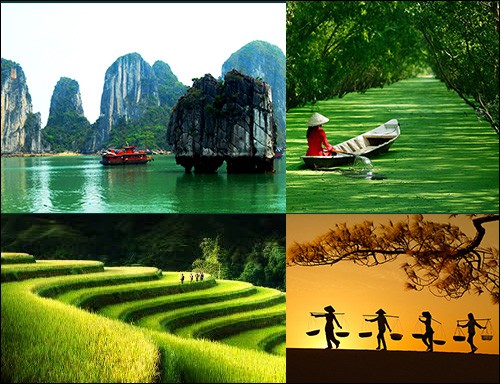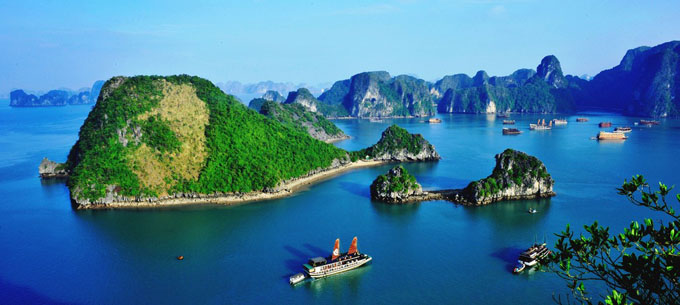Formerly a happening trading port in post-modern South East Asia,
Hoi An is now famous for being an exotic tourist attraction in the South Central Vietnam. This UNESCO World Heritage site offers its guesses a peaceful ambiance. Most of the time, tourists prefer to visit Hoi An’s classic architecture and religious sites as well as to purchase traditional souvenirs and bespoke clothing from the town’s renowned tailor shops.
However, Hoi An also offers a wide range of service for recreation and adventure, aside from sightseeing and shopping. With rustic paddle fields, bucolic villages, beautiful river, gorgeous beach and undamaged coral reef, Hoi An is the place for you to try out new things. Below are the 5 most interesting activities to do in Hoi An, proposed by foreign tourists and backpackers.
1. Joining a cooking tour
Probably not for daring adventurers but a brilliant idea for families, the tour is a daytrip to Thuan Tinh Island on Thu Bon River. It will take place from morning until noon and transportation will be provided by the tour organizer.
The first destination is a local wet market, where you will see how Vietnamese normally sell and purchase their food. All the ingredients there are organic though it is advisable to ask your guides on how to choose the freshest and tastiest if you want to purchase. Next, it will take you 40 minutes of relaxation and sight-seeing along Thu Bon River on a ferry to Thuan Tinh Island. Here you will have another 30-minute-row-boat ride under coconut glove to discover the local village. From time to time, you will get to rest and enjoy tropical fruits and juice.

The cooking class is outdoor and open to fresh air. Both the chef and the guide are knowledgeable, friendly and helpful. You will be instructed on how to cook the most famous Vietnamese dishes, namely Pho Bo (Beef Pho ), Nem Cuon (Spring Roll), Banh Xeo (Vietnamese Pancake), etc. Believe it or not, Vietnamese food are inherently good and easy to cook so don’t have worry much about your own cooking experience. The fun is to try your self-made dishes and gauge your own cooking ability.
The price is $35 per pax, not extremely inexpensive but definitely worthwhile, given all the transportation along with the food and fun that you will get to enjoy. Contact us for more information about the tour and booking.
2. Rent a bike and discover the countryside
Hoi An has been well known for its old houses, temples, pagodas and bridges. However, outside this small town is a totally different landscape with rice field, fisher villages, river and beach that you certainly do not want to miss.
The ideal transport for this expedition is bicycle. Bicycle renting service is ubiquitous in Hoi An. Paying about $2-3 and you will have that bicycle for a whole day, riding anywhere as you wish. Some hotels like Ha An even lend their bikes to their residents without any extra charge.
Cycling slowly through narrow paths along vast paddy fields, discovering how locals live their daily life and relaxing on the unspoiled beach of Cua Dai, you will find the peace of life that hardly other places in Vietnam can offer. The cordial villagers will help if you happen to get lost. On the beach, you can sunbathe, swim and eat: the seafood here is the freshest in the region as fisher village is just nearby. The price of renting a sun lounger for one day is as cheap as buying a water bottle. A good news for bingers is that restaurants and bars are open until night.
Though thrilling and adventurous, especially when you ride in group, travelling on your own in an unfamiliar area may be quite challenging for some. One alternative is to have a guided tour. There is a range of service, from half day to overnight homestay. Riding on robust sport bikes, you will be guided to visit the best places near the old town. Prices ranging from $24 (for half-day tour) to $89 (for overnight homestay).
3. Scuba diving and snorkelling
The sport has just been around for 4 years in the sea area surrounding Cu Lao Cham Island, which is 25 nautical miles from the coast of Cua Dai. Therefore, this is a relatively new diving site. You will not be annoyed by so many divers and boats and have more chance to experience the unspoiled beauty of Cu Lao Cham’s seabed and coral reef.
The best time in year to dive in Cu Lao Cham is from April to October when the water is warm and calm and underwater vision is clear. There are suitable times during other months too but chances are you will be disappointed by gloomy weather. Currently, Cu Lao Cham has three major commercial diving sites: Hon Dai, Hon Tai and Hon Mo. You can opt for either snorkeling or scuba-diving. Snorkeling is wearing a snorkel tube and floating underwater near the surface. You need to hold your breath when diving this way and thus cannot go too deep. But the good thing is that you do not need any experience to snorkel. Scuba-diving, on the other hand, requires some skills and knowledge. With gas tank and tight diving suit, you can venture 5-7 meters deep into the water, take some picture and play with the fish.
If you are new to diving but too enthusiastic about discovering the seabed then there is one company called Blue Coral Diving. This is a 5-star PADI dive center which offers courses in scuba diving. The instructors are experienced Vietnamese and foreign divers. There are three levels of course, ranging from Beginner and Advanced to Professional. The price starts from $250 and you will get discount if you come in group. For Beginners and Advanced levels, the course only lasts for 2 to 4 days. Another PADI-certified company is Cham Island Diving, which offers both course and tour. The price for one diving session is not too expensive, ranging from $42 to $80 per pax.
4. Become a one-day farmer in Tra Que Village
Fed up with luxury and want to experience some frugality? Just take a ride to
Tra Que Village, put your conical leaf hat on and start hoeing, plowing and watering like a real farmer.

Located 3 kilometers to the northeast of Hoi An’s old town, Tra Que is a typical Vietnamese village with green gardens and fields. Being instructed by local farmers, you will have one morning working under the sun to understand how the tasty dishes that you enjoy in Hoi An comes about. You will also gain great insight into traditional Vietnamese farming method. The trip will prove instructive to those home gardeners as you will acquire some very helpful tips about growing and tending plants from the local professionals. After a morning of hard physical work, lunchtime is when you will be taken care of. Foot message is often included in some of these “farmer” tours. Professional staff will help you get rid of stress and tension in your body and mind. Another reward is food and drink made of organic food grown in the village.
Most of these day trips are cycle-tour as you will get to the village by bikes. Along the way, you will have the chance to discover Hoi An’s fishing village and observe farmers catching fish by nets from their row boats. The price is about $30 per pax, quite reasonable given the insight, hand-on skills and good food you will get.
5. Relax at a Spa (finally)
We have been through cooking, cycling, diving and farming, which are all in authentic Hoi An and Vietnamese style. Alas, after all of these adventures and physical activities, our last recommendation for your fulfilling experience in Hoi An is all about relaxation and invigoration.
Although there are many spas in Hoi An, Palmarosa Spa is the first one that uses only pure natural products and ingredients in their therapies. This, combined with professional staffs and service, makes it the number one in Hoi An. You will feel relaxed and peaceful from the very first moment walking into Palmarosa. The staffs just couldn’t do enough to help you. They are always ready to welcome you with herbal teas and foot soak, even before you choose your treatments. Facilities are new and clean, and the spa is artistically decorated in East Asian style. Once inside Palmarosa, with soft glowing light and cool refreshing air surrounding, all you want to do is to pull over and take a nap, especially if you have just come back from a hectic day trip or lengthy tiresome flight.
But wait, you still need to order your service! Palmarosa Spa has a variety of therapies and treatments to offer you: the thirty-minute Indian head therapy, the sixty-five-minute foot reflexology, the seventy-five-minute Basalt Hot Stone body therapy, etc. And don’t forget to try the ninety-minute Palmarosa Spa Signature (which sounds like something really special!). The prices range from $11 to $43, slightly more expensive than other local spas but don’t bother since the money will go with quality!
Palmarosa Spa is on 90 Ba Trieu Street, just 9 minutes walking from the town’s center. The spa is open from 10am to 9pm and last booking is at 8pm. So if you are in staying in Hoi An, don’t hesitate, come to the place and have a relaxing experience!
































.jpg)

.jpg)

.png)













